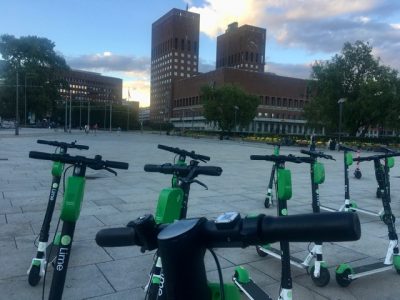After nearly two years of urban chaos, Norway’s transport ministry is finally proposing some new regulation of electric scooters that are loved by some and hated by others. Scooter operators and users face new parking rules, speed limits and other restrictions, but enforcing them will remain a challenge.

The state highway department (Statens vegvesen), acting on a request from the transport ministry, has sent a list of new regulatory proposals to hearing that would apply to both el-scooters (called elsparkesykler in Norwegian) and other small electric vehicles. If approved they’ll impose regulations nationwide that include a ban on parking on sidewalks, a speed limit of 6 kilometers per hour on pedestrian walkways, mandatory use of helmets, the same blood alcohol limit of 0.2 percent that applies to all motorists, a ban on use of the el-scooters by more than one person at a time and by anyone under age 12, with demands for ID.
Local communities will also be allowed to set up no-parking zones for such small electric vehicles and impose other rules, while violators can be cited and fined by police and/or Statens vegvesen officials.
See the full list of proposed regulations here (external link to the transport ministry’s website, in Norwegian only).
State transport ministry officials have been under heavy criticism for not having acted sooner. The el-scooters, which started appearing in Norway in late 2018, were allowed under the same rules that the conservative Progress Party ushered in several years ago for use of Segways, which never caught on in Norway.
It didn’t take long for complaints about the el-scooters to start rolling in, and they escalated quickly. Trondheim tried banning them, only to lose in court because they had no state authority to keep operators from leasing them out as a form of public transport and “micro-mobility.” They became wildly popular, especially with teenagers and young adults who prefer them over walking and for getting home after late-night partying when other forms of public transport were no longer running. Their use grew during the Corona crisis, when state health officials discouraged the use of bus, tram and metro systems.

Former Transport Minister Jon Georg Dale of the Progress Party, which had opened up for their introduction in Norway, failed to act on demands that he “do something” when local governments were thwarted. He was replaced by Knut Arild Hareide of the Christian Democrats in January, who immediately faced calls to address the el-scooter chaos especially after a string of serious accidents. Doctors at Oslo’s emergency hospital (Legevakt) were among those adding to the complaints after, according to state broadcaster NRK, no less than 729 injuries were reported between April and August this year. More than half of them occurred after 10pm, and involved drunk users.
Newspaper Dagsavisen was among Norwegian media clamouring for regulation of the el-scooters, and scolding Hareide for being “too passive” in his response to the problem. “How complicated and difficult can it be,” wondered commentator Lars West Johnsen last month, “when everyone agrees that regulation is urgently needed.”
‘Take back the sidewalks’
Johnsen’s plea came after an ever-rising number of operators keen to cash in on the el-scooter rental trend had agreed among themselves to “clean up” some of the el-scooter mess. They hired in people to assemble scooters left lying in the middle of sidewalks, building entries or public parks and plazas. “We understand people are frustrated,” admitted the head of scooter lender Voi to newspaper Dagens Næringsliv (DN) in August. “Neither residents, users, others on the sidewalk and roads or we operators are well-served with the situation as it is now.”
Pedestrians have also organized in an effort “to take back the sidewalks,” and Hareide publicly agreed. He made a point of claiming that the el-scooters can be a “positive addition to urban areas,” and contribute to zero-emission mobility. “At the same time” he added, “we see major challenges with them, especially because there’s become so many of them.”
Hareide was on national radio Wednesday morning, saying that he thinks the new proposed regulations “will make it safer to use el-scooters,” He told state broadcaster NRK that “we will solve the parking problems,” adding that “too many el-scooters are left lying around and we can’t have that any longer.”
Enforceability issues
The hearing period runs until February 1, after which his ministry will send proposed national regulations to Parliament, where the government is likely to win a majority. He hopes new rules can be in place by spring 2021, but then they’ll need to be enforced. Police have already complained that they lack capacity to chase after errant scooter drivers, monitor their speed or issue citations. It also remains unclear how blood alcohol levels will be tested, although scooters may be equipped with meters that won’t allow them to be used if an operator is over the limit.
Calls have gone out earlier for the scooters to just be shut down for use after 10pm, but operators don’t want to give up the income. Operators were also already objecting on Wednesday to the proposed ban against parking an el-scooter on sidewalks, and they don’t think adult users should be required to use helmets.
“That can dampen people’s eagerness to use this new mode of transport,” Christina Moe Gjerde of Voi told NRK. She wants to see more development of infrastructure with designated scooter parking. Others don’t want the scooters to be used among pedestrians at all. The hearing process is thus expected to be lively over the next six weeks.
NewsInEnglish.no/Nina Berglund

